Pipedreams Euro-Tour
April 28 - May 11, 2006
Obermarchtal (Abbey Church Saint Peter & Paul)
On the site of the present church, there was a small Benedictine abbey church already in 776. In 1171, it became a Premonstratensian monastery, a new church was built in 1239, replaced by the present abbey church and monastery buildings in 1689-1701 by the famous builder, Michael Thumb. After the secularization, the church was owned by the Counts of Thurn and Taxis and became a parish church. In 1973, the archdiocese of Rottenburg bought the monastery buildings and established a clerical institution for the education of teachers. Note the valuable stuccos in the interior, made by Johann Schmuzer from Wessobrunn in 1689 and the high-altar and choir stalls from 1697, made by Brother Paul Speisegger. Hans Rieger created the baroque choir screen in 1690. The pulpit, decorated with the four evangelists, Petrus, Paulus and the Good Shepherd, is made in 1711-19.
| |
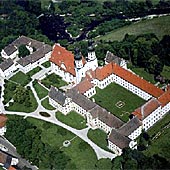 |
The gallery organ has been built in 1784 by Johann Nepomuk Holzhey, who also built a choir organ in 1780 (not preserved). Although this instrument has been rebuilt several times, it still has preserved its original warm sound and is considered as one of the best preserved instruments of the master beside Rot and Weissenau. In WWII, all front pipes had to handed over to the government and have been replaced meanwhile. As in Rot and in Ochsenhausen, here too, the organ cases had to be built in two divisions to keep the existing large windows feee. But here too, Holzhey built a Kronpositiv (Echo) that bridges the two halfs of the organ cases and provides a visual unit. Since Holzhey had given up the idea to built a Rückpositiv, instead, he built a Unterwerk underneath the center window. In front of this Unterwerk, he placed the detached console.
Links and resources
Sigmaringen (Saint Johann’s Church)
At this site, in 1247, there was a chapel of the former castle, that was rebuilt in 1583. This church was replaced by the present church in 1756-1763 that kept only the North wall and tower of the previous church. The interior furnishings were made by famous artists like Jakob Schwarzmann (stuccos) and Joh. Michael Feichtmayr (altars), and Saint Johann is considered as one of the most remarkable Baroque churches in this region.
A first organ is mentioned in 1681. When the building of the new Baroque church had been completed, two new organs were installed, a gallery organ and a choir organ, separated in two halves right and left in the chancel. The gallery organ, with Hauptwerk, Rückpositiv and Pedal, had been given by Prince Karl Friedrich of Hohenzollern and had been built in 1762 by Johann Georg Aichgasser from Überlingen.
Links and resources
Hechingen (Stiftskirche Saint Jakobus)
| |
 |
The previous Stiftskirche (Collegiate church) had been built in 1472-88 in Gothic style at this site. Under the reign of Count Friedrich Wilhelm, the present church was built in 1779-1783 in classical style by the famous French architect, Michel d’Ixnard. Most of the interior is preserved: paintings above the five altars by Josef Melling, ceiling paintings by Meinrad von Aw, Late-Gothic Madonna statue at left side altar (16th c.), and the patron of the church, Saint Jakobus at the right side altar (16th c.), underneath the chancel is the gravesite of the Countess Eugenie and her husband, Count Konstantin von Hohenzollern-Hechingen.
In 1589, a contract was signed with organ builder Konrad Beck from Pforzheim for a new organ at the (previous) parish church. After the present new church building had been completed, a new organ was installed, built in 1781 by the local organ builder, Konrad Keppner. In the 18th century, the city of Hechingen could boast about two organ builders, Keppner and Georg Aichgasser (1701-1767). The latter built among others new organs in Birnau and Salem.
In 1846, 65 years later, the instrument underwent a considerable rebuilt by Joseph Klingler from Stetten. The wind supply was improved, the pipework was cleaned and enlarged to meet the expectations of the changed sound idea of the Romantic period. Finally, in 1939, the organ company Gebr. Spaeth from Ennetach replaced the old instrument by a new organ of 48 stops on three manuals and pedal. Again, this organ proved as not very reliable and eventually was unplayable. 1991, an interims choir organ with 12 stops built by Pfaff had been provided while plan were underway for two completely new instruments.
These two organs, a gallery organ and a choir organ, have been built by Goeckel Orgelbau from Heidelberg in 2004. The cube form of the gallery organ is orientated at the architectonic form of the gallery and is thought to crown this gallery. In the choir organ, form elements of the gallery organ have been taken over. The facade has two sides. From a movable general console in the chancel, both organs are playable.
Links and resources
Hechingen (Saint Luzen)
Both the Saint Luzen church and its organ represent interesting artistic monuments for Baden-Württemberg. The church, formerly a monastic building, is one of the few remaining ecclesiastical structures of the 16th century. Its history can be traced back to 1318. An organ is first mentioned at the time of a later rebuilding, in the years 1586 to 1589, under the Hohenzollern Graf Eitelfriedrich IV. He entered into a contract with the organ-builder Konrad Beck, of Pforzheim, for the building of organs for both the Hechingen Stiftskirche and Saint Luzen. From the contract, it may be deduced that there already was a small organ in the Saint Luzen church. This was to be radically rebuilt by Konrad Beck.
| |
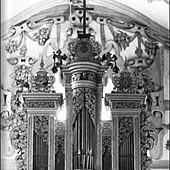 |
In the course of the baroque alteration of the church at the beginning of the 18th century, a new west gallery was built in 1713, and at the same time a new organ. Its builder was Urban Reitter, organ builder from Hayingen (born 1672). Since the gallery was to be used for the monastic choir, a screen was placed at the front, consisting of open work, over which wooden volutes were crowned with turned pyramidal pinnacles, and the organ case is composed in the middle of this structure. This is also the reason why the organ has two case fronts: facing east, with a projecting central tower and various baroque ornamentation, and, facing west, a renaissance front with flats, standing over the console. It is of interest that the east contains 45 pipes of the Principal 4′, and the west, all the pipes of the Quint 3′. The instrument, of course, has had to undergo various operations over the years. It was therefore no longer possible to re-establish the state as of 1713. By 1975, all the woodwork (pipe bodies, soundboards, and parts of the action) was so worm infested that there could be no thought of just making good, and the only possibility was a reconstruction according to the original design. These works were executed by Werner Bosch from Kassel in 1975.
Links and resources
The day to day…

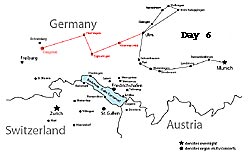
 Notes from the Road - travel log, day 6
Notes from the Road - travel log, day 6 Michael Barone’s pictures from the tour
Michael Barone’s pictures from the tour Images from Obermarchtal Abbey
Images from Obermarchtal Abbey Images from Saint Johann, Sigmaringen
Images from Saint Johann, Sigmaringen Images from Saint Jakobus, Hechingen
Images from Saint Jakobus, Hechingen Images from Saint Luzen, Hechingen
Images from Saint Luzen, Hechingen Day 5 - Ulm & Neresheim
Day 5 - Ulm & Neresheim Day 7 - Schramberg & Freiburg
Day 7 - Schramberg & Freiburg Main Tour Page
Main Tour Page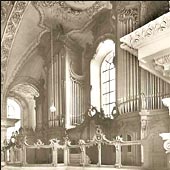

 Notes from the Road - travel log, day 6
Notes from the Road - travel log, day 6 Images from Obermarchtal Abbey
Images from Obermarchtal Abbey Pictures & History of the organ
Pictures & History of the organ Find detailed organ specifications in our Tour Book
Find detailed organ specifications in our Tour Book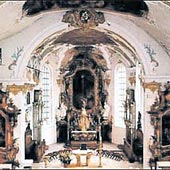
 Notes from the Road - travel log, day 6
Notes from the Road - travel log, day 6 Images from Saint Johann, Sigmaringen
Images from Saint Johann, Sigmaringen Find detailed organ specifications in our Tour Book
Find detailed organ specifications in our Tour Book
 Notes from the Road - travel log, day 6
Notes from the Road - travel log, day 6 Images from Saint Jakobus, Hechingen
Images from Saint Jakobus, Hechingen Images & organ specification by Göckel Organbuilders
Images & organ specification by Göckel Organbuilders Find detailed organ specifications in our Tour Book
Find detailed organ specifications in our Tour Book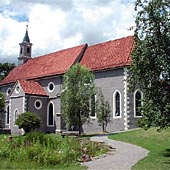

 Notes from the Road - travel log, day 6
Notes from the Road - travel log, day 6 Images from Saint Luzen, Hechingen
Images from Saint Luzen, Hechingen Description of Saint Luzen
Description of Saint Luzen Find detailed organ specifications in our Tour Book
Find detailed organ specifications in our Tour Book

